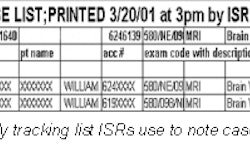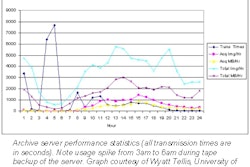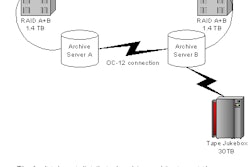PACS can make the cost savings add up pretty quickly. By phasing out a film library and its associated personnel, eliminating consumables such as processors and film, and raking in revenues from higher productivity, digital image management can help any facility bolster its bottom line. But installing a PACS without a RIS to associate reports with the correct studies can be penny-wise and pound-foolish.
Dr. Ingmar Kaden and colleagues at the Clinic for Diagnostic and Interventional Radiology in Haale/Saale, Germany learned this lesson firsthand. Although the institution had originally installed only a PACS (Impax, Agfa Medical, Ridgefield Park, NJ), it ended up also needing a RIS (GAP Organisationsberatung & Software-Entwicklung, Manheim, Germany) to integrate and manage a high volume of reports and images.
The facility generates approximately 1.5 terabytes of digital image data annually. It has 10 clinical departments, 460 beds, and performs more than 37,000 radiology procedures a year, including 7,000 CT studies and 2,700 MR exams.
In an effort to determine how the RIS installation was affecting the bottom line, Kaden and fellow researchers set out to measure its impact. In a presentation at the 2001 European Congress of Radiology in Vienna, Kaden outlined the methodology his team used to quantify the savings achieved with a RIS/PACS installation.
The group first looked at the workflow processes that were relevant to the RIS. They determined that there were six activities that defined the RIS workflow:
- Archive administration
- Information transport
- Search processes
- Document administration
- Hard-copy management
- Maintenance of information and communication technology
They further defined the process as "management of an order for image diagnostic procedures starting with registration and ending with report checkout," Kaden said.
The researchers then performed an analysis of process costs, investment by the facility in capital acquisition of the integrated RIS/PACS, and the annual maintenance costs associated with both the film and the RIS/PACS environments. From this data, they were able to calculate annual operating costs of 371,716 euros ($318,436) before the introduction of the RIS/PACS. This cost was cut by more than half, to 174,310 euros ($149,334), by introducing an integrated system.
Overall, the team found that a savings of approximately 383,469 euros ($327, 942) was achieved by the use of RIS/PACS technology versus traditional film-based radiology. Although the numbers were good, and meant the institution would see a return on investment in approximately four to five years, Kaden and his team drilled down into the data further to break out the time and cost savings of integrating the RIS into the PACS.
"Our data showed the average amount of work time for one process to be completed in the hospital was about 45 minutes without the integrated system," said Kaden. "When we combined the RIS with our PACS, we saw an 85% reduction in work time per process," he added.
The cost savings achieved in administrative work per process were equally as dramatic. "Our cost per process for administration went from 15 euros ($12.83) to a little under 5 euros ($4.28) with the introduction of the RIS/PACS," Kaden noted. Overall, the diagnostic and therapeutic process has been reduced by about 25% on an average, he observed.
The group determined that from the clinical point of view the RIS/PACS had intensified the workflow of the facility, leading to a more efficient use of hospital resources and the providing of care to more patients on an annual basis. From an economic standpoint, the RIS/PACS proved that it was able to not only return the cost of investment, but also to free up capital that could be used to improve services in the department.
"Applying IHE (Integrated Healthcare Enterprise) systems such as a RIS/PACS has enabled us to not only compensate the annual refinancing of our department but to create new job profiles as well," Kaden said.
By Jonathan S. BatchelorAuntMinnie.com staff writer
June 1, 2001
Related Reading
RIS/PACS integration defeats data duplication, May 11, 2001
IHE's effects on PACS implementation, February 21, 2001
How far has systems integration evolved in PACS?, February 20, 2001
IHE looks for more participation by HIS vendors, other specialties, February 6, 2001
Japanese researchers address challenge of multivendor PACS, January 25, 2001
Click here to post your comments about this story in our PACS Digital Community. Please include the headline of the article in your message.
Copyright © 2001 AuntMinnie.com



















